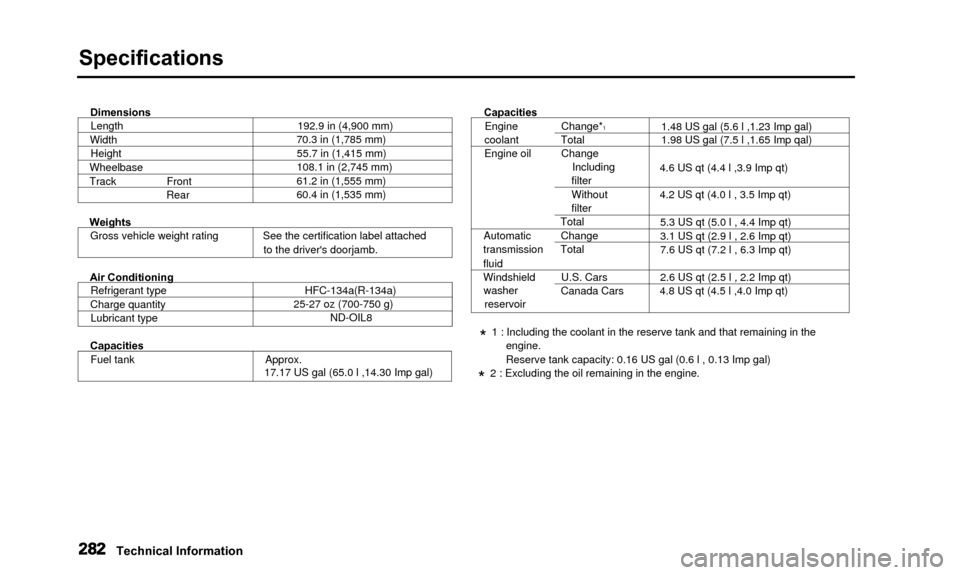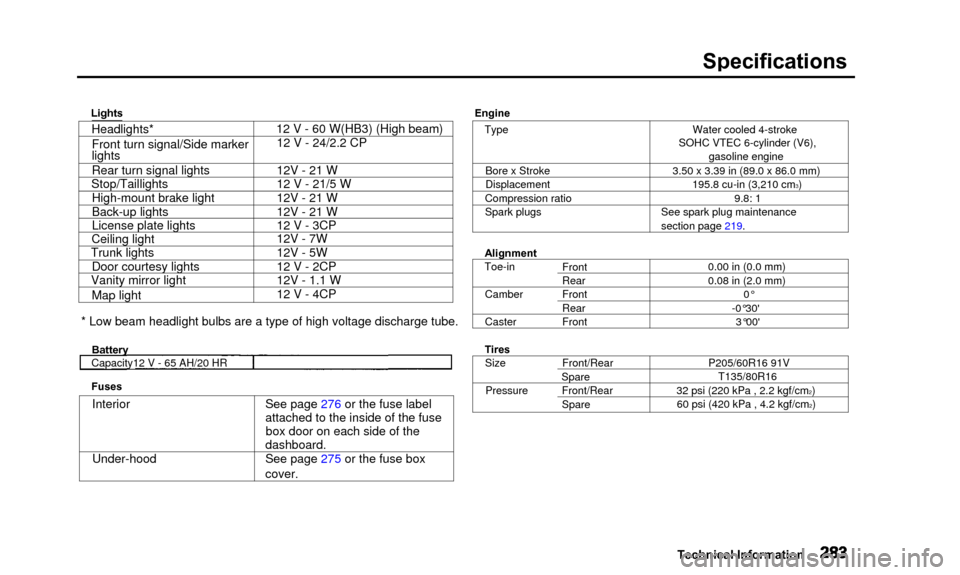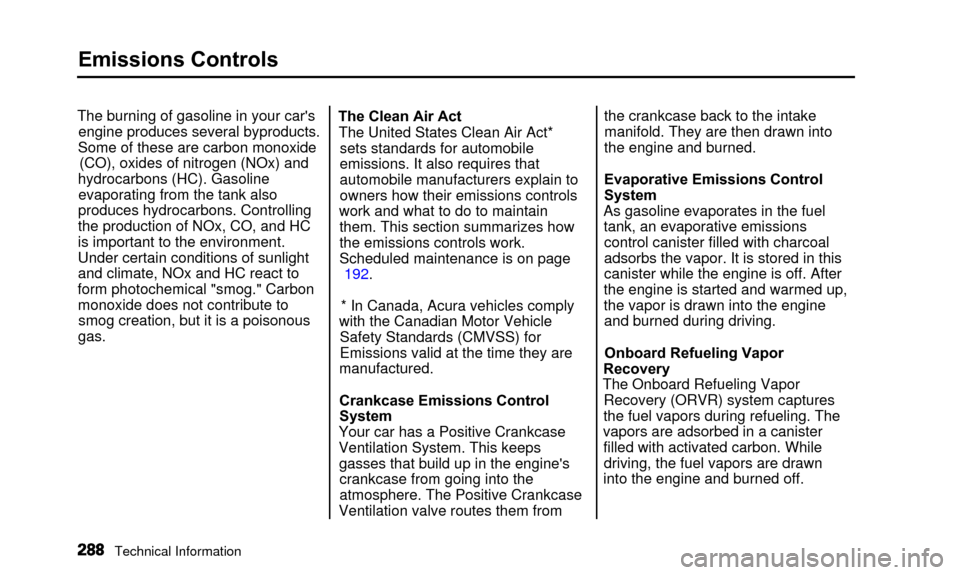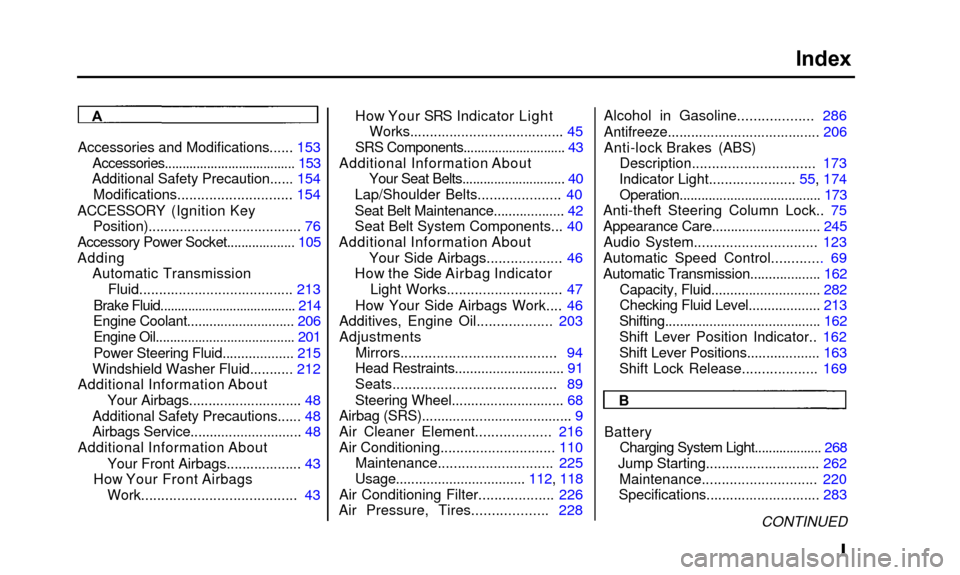engine Acura TL 2000 3.2 Manual Online
[x] Cancel search | Manufacturer: ACURA, Model Year: 2000, Model line: TL, Model: Acura TL 2000Pages: 311, PDF Size: 3.05 MB
Page 280 of 311

Emergency Towing
If your car needs to be towed, call a
professional towing service or, if you
belong to one, an organization that
provides roadside assistance. Never
tow your car behind another vehicle
with just a rope or chain. It is very dangerous.
There are three popular types of professional towing equipment:
Flat-bed Equipment — The operator
loads your car on the back of a truck.
This is the best way to transport
your Acura.
Wheel-Lift Equipment — The tow
truck uses two pivoting arms that go
under the tires (front or rear) and lift
them off the ground. The other two
tires remain on the ground. This is an acceptable way to tow your
Acura.
Sling-type Equipment — The tow
truck uses metal cables with hooks on the ends. These hooks go around
parts of the frame or suspension and
the cables lift that end of the car off
the ground. Your car's suspension and body can be seriously damaged.
This method of towing is unacceptable.
If your Acura cannot be transported
by flat-bed, it should be towed by
wheel-lift equipment with the front
wheels off the ground. If, due to damage, your car must be towed
with the front wheels on the ground, do the following.
• Release the parking brake.
• Start the engine.
• Shift to D5, then to N.
• Turn off the engine.
Improper towing preparation will
damage the transmission. Follow the
above procedure exactly. If you cannot
shift the transmission or start theengine, your car must be transported
with the front wheels off the ground.
• With the front wheels on the ground, it is best to tow the car no
farther than 50 miles (80 km), and
keep the speed below 35 mph (55
km/h).
CONTINUED
Taking Care of the Unexpected
NOTICE
Page 283 of 311

Identification Numbers
Your car has several identifyingnumbers located in various places.
The Vehicle Identification Number (VIN) is the 17-digit number your
Acura dealer uses to register your car for warranty purposes. It is alsonecessary for licensing and insuring
your car. The easiest place to find the VIN is on a plate fastened to the
top of the dashboard. You can see it
by looking through the windshieldon the driver's side. It is also on theCertification label attached to the
driver's doorjamb, and is stamped on
the engine compartment bulkhead.
The VIN is also provided in bar code on the Certification label.VEHICLE IDENTIFICATION NUMBER
CERTIFICATION LABEL
Technical Information
Page 284 of 311

Identification Numbers
The Engine Number is stamped intothe engine block. It is on the front.
The Transmission Number is on a label on top of the transmission.
ENGINE NUMBER
AUTOMATIC TRANSMISSION NUMBER Technical Information
Page 285 of 311

Specifications
DimensionsLength
Width Height
Wheelbase
Track Front Rear 192.9 in (4,900 mm)
70.3 in (1,785 mm)
55.7 in (1,415 mm)
108.1 in (2,745 mm)
61.2 in (1,555 mm)
60.4 in (1,535 mm) Capacities
Weights
Gross vehicle weight rating See the certification label attached to the driver's doorjamb.
Air Conditioning
Refrigerant type
Charge quantity Lubricant type HFC-134a(R-134a)
25-27 oz (700-750 g) ND-OIL8
Engine
coolant
Engine oil
Automatic
transmission
fluid
Windshield washer
reservoir Change*1Total
Change Including
filter
Without
filter
Total
Change
Total
U.S. Cars
Canada Cars 1.48 US gal (5.6 l ,1.23 Imp gal)
1.98 US gal (7.5 l ,1.65 Imp qal)
4.6 US qt (4.4 l ,3.9 Imp qt)
4.2 US qt (4.0 l , 3.5 Imp qt) 5.3 US qt (5.0 l , 4.4 Imp qt)
3.1 US qt (2.9 l , 2.6 Imp qt)
7.6 US qt (7.2 l , 6.3 Imp qt)
2.6 US qt (2.5 l , 2.2 Imp qt)
4.8 US qt (4.5 l ,4.0 Imp qt)
Capacities
Fuel tank Approx. 17.17 US gal (65.0 l ,14.30 Imp gal)
* 1 : Including the coolant in the reserve tank and that remaining in the
engine.
Reserve tank capacity: 0.16 US gal (0.6 l , 0.13 Imp gal)
* 2 : Excluding the oil remaining in the engine.
Technical Information
Page 286 of 311

Specifications
Lights
TypeBore x Stroke
Displacement
Compression ratio
Spark plugs
Alignment
Toe-in Camber
Caster
Tires Size
Pressure Front
Rear
Front
Rear
Front
Front/Rear
Spare Front/Rear
Spare Water cooled 4-stroke
SOHC VTEC 6-cylinder (V6), gasoline engine
3.50 x 3.39 in (89.0 x 86.0 mm) 195.8 cu-in (3,210 cm
3)
9.8: 1
See spark plug maintenance
section page 219.
0.00 in (0.0 mm)
0.08 in (2.0 mm)0°
-0°30' 3°00'
P205/60R16 91V T135/80R16
32 psi (220 kPa , 2.2 kgf/cm
2)
60 psi (420 kPa , 4.2 kgf/cm2)
Technical Information
Headlights* Front turn signal/Side marker
lights
Rear turn signal lights
Stop/Taillights
High-mount brake light
Back-up lights
License plate lights
Ceiling light
Trunk lights
Door courtesy lights
Vanity mirror light
Map light 12 V - 60 W(HB3) (High beam)
12 V - 24/2.2 CP
12V - 21 W
12 V - 21/5 W
12V - 21 W
12V - 21 W
12 V - 3CP
12V - 7W
12V - 5W
12 V - 2CP
12V - 1.1 W
12 V - 4CP
* Low beam headlight bulbs are a type of high voltage discharge tube.
Battery
Fuses
Interior
Under-hood See page 276 or the fuse label
attached to the inside of the fuse
box door on each side of the
dashboard.
See page 275 or the fuse box
cover.
Capacity12 V - 65 AH/20 HR
Engine
Page 291 of 311

Emissions Controls
The burning of gasoline in your car'sengine produces several byproducts.
Some of these are carbon monoxide (CO), oxides of nitrogen (NOx) and
hydrocarbons (HC). Gasoline evaporating from the tank also
produces hydrocarbons. Controlling the production of NOx, CO, and HC
is important to the environment.
Under certain conditions of sunlight
and climate, NOx and HC react to
form photochemical "smog." Carbon monoxide does not contribute tosmog creation, but it is a poisonous
gas. The Clean Air Act
The United States Clean Air Act* sets standards for automobile
emissions. It also requires that
automobile manufacturers explain to
owners how their emissions controls
work and what to do to maintain them. This section summarizes how
the emissions controls work.
Scheduled maintenance is on page 192.
* In Canada, Acura vehicles comply
with the Canadian Motor Vehicle Safety Standards (CMVSS) for
Emissions valid at the time they are
manufactured.
Crankcase Emissions Control
System
Your car has a Positive Crankcase
Ventilation System. This keeps gasses that build up in the engine'scrankcase from going into the
atmosphere. The Positive Crankcase
Ventilation valve routes them from the crankcase back to the intake
manifold. They are then drawn into
the engine and burned.
Evaporative Emissions Control
System
As gasoline evaporates in the fuel tank, an evaporative emissionscontrol canister filled with charcoal
adsorbs the vapor. It is stored in this
canister while the engine is off. After
the engine is started and warmed up,
the vapor is drawn into the engine and burned during driving.
Onboard Refueling Vapor
Recovery
The Onboard Refueling Vapor Recovery (ORVR) system captures
the fuel vapors during refueling. The
vapors are adsorbed in a canister filled with activated carbon. Whiledriving, the fuel vapors are drawn
into the engine and burned off.
Technical Information
Page 292 of 311

Emissions Controls
Exhaust Emissions Controls
The exhaust emissions controls include four systems: PGM-FI,
Ignition Timing Control, ExhaustGas Recirculation and Three Way
Catalytic Converter. These foursystems work together to control the
engine's combustion and minimize
the amount of HC, CO, and NOx that comes out the tailpipe. The exhaust
emissions control systems areseparate from the crankcase and
evaporative emissions control systems.
PGM-FI System
The PGM-FI System uses sequential multiport fuel injection.
It has three subsystems: Air Intake,
Engine Control, and Fuel Control.
The Engine Control Module (ECM) or the Powertrain Control Module (PCM) uses various sensors to
determine how much air is going
into the engine. It then controls how
much fuel to inject under all operat- ing conditions.
Ignition Timing Control System
This system constantly adjusts the ignition timing, reducing the amountof HC, CO and NOx produced.
Exhaust Gas Recirculation (EGR)System
The Exhaust Gas Recirculation (EGR) system takes some of the
exhaust gas and routes it back into
the intake manifold. Adding exhaust gas to the air/fuel mixture reduces
the amount of NOx produced when
the fuel is burned.
Three Way Catalytic Converter
The three way catalytic converter is in the exhaust system. Through
chemical reactions, it converts HC,CO, and NOx in the engine's exhaust
to carbon dioxide (CO
2), dinitrogen
(N
2), and water vapor. Replacement Parts
The emissions control systems are designed and certified to work to-
gether in reducing emissions to
levels that comply with the Clean Air
Act. To make sure the emissions remain low, you should use only newGenuine Honda replacement parts or
their equivalent for repairs. Using
lower quality parts may increase the emissions from your vehicle.
The emissions control systems are covered by warranties separate from
the rest of your car. Read your
warranty manual for more informa-
tion.
Technical Information
Page 293 of 311

Three Way Catalytic Converter
The three way catalytic convertercontains platinum, palladium and
rhodium. These metals serve as
catalysts, promoting chemical
reactions to convert the exhaust
gasses without affecting the metals.
The catalytic converter is referred to as a three-way catalyst, since it acts
on HC, CO, and NOx. A replacement
unit must be an original Acura part
or its equivalent.
The three way catalytic converter must operate at a high temperature
for the chemical reactions to take
place. It can set on fire any com-
bustible materials that come near it.Park your car away from high grass,
dry leaves, or other flammables.
THREE WAY CATALYTIC CONVERTER
A defective three way catalytic converter contributes to air pollution,
and can impair your engine's per-
formance. Follow these guidelines toprotect your car's three way catalyticconverter.
• Always use unleaded gasoline.
Even a small amount of leaded
gasoline can contaminate the
catalyst metals, making the three
way catalytic converter ineffective.
• Keep the engine tuned-up.
• Have your car diagnosed and repaired if it is misfiring, back-
firing, continuing to run after you
turn off the engine, stalling, or
otherwise not running properly.
Technical Information
Page 301 of 311

Authorized Manuals
NOTE: Dealers and Companies please provide dealer or company name,
and also the name of the person to whose attention the shipment should
be sent. For purchases outside U.S.A. please write to the address shown
below for a quotation.
Customer Name
Street Address - No P.O. Box NumberApartment Number State & Zip Code
Daytime Telephone Number ( ).
Check or money order enclosed payable to Helm Inc — U.S. funds only. Do not send cash
These Publications cannot be returned for credit without receiving advan\
ce authorization within 14 days of delivery. On returns, a restocking fee may be applied against th\
e original order.
P.O. BOX 07280-DETROIT, MICHIGAN 48207-1-800-782-4356Service Manual:
This manual covers maintenance and recommended procedures for repair to engine and chassis components.It is written for the Journeyman mechanic, but is simple
enough for most mechanically-inclined owners to under-
stand.
Electrical Troubleshooting Manual:
This manual complements the Service Manual by providing in-depth troubleshooting information for eachelectrical circuit in your vehicle.
Body Repair Manual:
This manual describes the procedures involved in the replacement of damaged body parts.
Master
Card VISA Check here if your billing address is differentfrom the shipping address shown above.
Expiration: Mo. Yr.
CUSTOMER SIGNATURE DATE
Page 302 of 311

Index
Accessories and Modifications...... 153
Accessories..................................... 153
Additional Safety Precaution...... 154
Modifications............................. 154
ACCESSORY (Ignition Key Position)........ .............................. . 76
Accessory Power Socket......... .......... 105
Adding Automatic Transmission Fluid......... .............................. 213
Brake Fluid......... .............................. 214
Engine Coolant......... .................... 206
Engine Oil....................................... 201
Power Steering Fluid................... 215
Windshield Washer Fluid......... .. 212
Additional Information About Your Airbags........ ..................... 48
Additional Safety Precautions...... 48
Airbags Service........ ..................... 48
Additional Information About
Your Front Airbags................... 43
How Your Front Airbags Work........ .............................. . 43How Your SRS Indicator Light
Works....................................... 45
SRS Components............................. 43
Additional Information About Your Seat Belts........ ..................... 40
Lap/Shoulder Belts..................... 40
Seat Belt Maintenance................... 42
Seat Belt System Components... 40
Additional Information About Your Side Airbags................... 46
How the Side Airbag Indicator Light Works............................. 47
How Your Side Airbags Work.... 46
Additives, Engine Oil................... 203
Adjustments Mirrors....................................... 94
Head Restraints........ ..................... 91
Seats........................................ . 89
Steering Wheel............................ . 68
Airbag (SRS)....................................... 9
Air Cleaner Element................... 216
Air Conditioning............................. 110
Maintenance......... .................... 225
Usage................................. . 112, 118
Air Conditioning Filter......... .......... 226
Air Pressure, Tires......... .......... 228Alcohol in Gasoline................... 286
Antifreeze.........
.............................. 206
Anti-lock Brakes (ABS) Description......... ...................... 173
Indicator Light......... ............. 55, 174
Operation....................................... 173
Anti-theft Steering Column Lock.. 75
Appearance Care............................. 245 Audio System............................... 123
Automatic Speed Control........ ..... 69
Automatic Transmission......... .......... 162
Capacity, Fluid............................. 282
Checking Fluid Level................... 213
Shifting.......................................... 162
Shift Lever Position Indicator.. 162
Shift Lever Positions................... 163
Shift Lock Release......... .......... 169
A
B
Battery Charging System Light................... 268
Jump Starting......... .................... 262
Maintenance............................. 220
Specifications......... .................... 283
CONTINUED